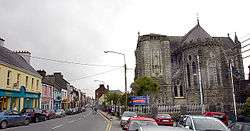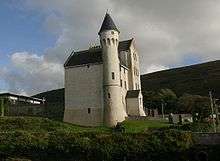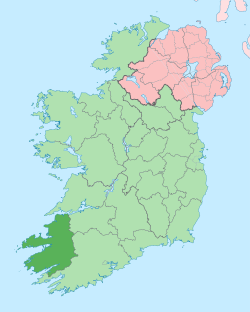Cahersiveen
Cahersiveen[7][8] (Irish: 'Cathair Saidhbhín', meaning "Little Sadhbh's stone ringfort") — alternate spellings Cahirsiveen, Cahirciveen or Caherciveen — is a town in County Kerry, Ireland. As of the 2016 CSO census, the town had a population of 1,041.[1]
Cahersiveen Cathair Saidhbhín | |
|---|---|
Town | |
 Cahersiveen | |
 Cahersiveen Location in Ireland | |
| Coordinates: 51.948°N 10.224°W | |
| Country | Ireland |
| Province | Munster |
| County | County Kerry |
| Elevation | 79 m (259 ft) |
| Population (2016)[1] | |
| • Urban | 1,041 |
| Irish Grid Reference | V469795 |
| Year | Pop. | ±% |
|---|---|---|
| 1831 | 1,192 | — |
| 1841 | 1,492 | +25.2% |
| 1851 | 1,862 | +24.8% |
| 1861 | 1,802 | −3.2% |
| 1871 | 1,925 | +6.8% |
| 1881 | 2,003 | +4.1% |
| 1891 | 1,987 | −0.8% |
| 1901 | 2,013 | +1.3% |
| 1911 | 1,896 | −5.8% |
| 1926 | 1,773 | −6.5% |
| 1936 | 1,680 | −5.2% |
| 1946 | 1,779 | +5.9% |
| 1951 | 1,687 | −5.2% |
| 1956 | 1,801 | +6.8% |
| 1961 | 1,659 | −7.9% |
| 1966 | 1,649 | −0.6% |
| 1971 | 1,547 | −6.2% |
| 1981 | 1,428 | −7.7% |
| 1986 | 1,310 | −8.3% |
| 1991 | 1,213 | −7.4% |
| 1996 | 1,250 | +3.1% |
| 2002 | 1,272 | +1.8% |
| 2006 | 1,294 | +1.7% |
| 2011 | 1,168 | −9.7% |
| [2][3][4][5][6] | ||
Geography
Cahersiveen is situated on the slopes of Bentee, and on the lower course of the River Ferta. It is the principal settlement of the Iveragh Peninsula, lies near Valentia Island, and is connected to the Irish road network by the N70 road.
History
Cahersiveen was where the first shots of the Fenian Rising were fired in 1867.
Railway
Cahersiveen was from 1893 to 1960 served by the Cahersiveen railway station on the Great Southern and Western Railway.[9]
Role in Literature
Patrick O'Brian's novel "Post Captain" gives Cahersiveen as the location of the character Stephen Maturin's childhood home in Ireland.
- At present two Highlanders were talking slowly to an Irishman in Gaelic, as he last there on his stomach to ease his flayed back. 'I follow them best when I do not attend at all,' observed Stephen, 'it is the child in long clothes that understands, myself in Cahirciveen."[10]
The novel is part of the Aubrey-Maturin series of novels set during the Napoleonic wars. The story of visiting his home in Ireland is used by Stephen Maturin to cover espionage in France and Catalonia. The ruse is satirised when another character observes:
- In Ireland? You astonish me. Every time I have been in Ireland it has rained. If you had not told me, I should have sworn you had been in the Med, ha, ha, ha.[10]
Religion

The Catholic church in the town is the only one in Ireland named after a layperson, Daniel O'Connell.[8] It also contains a decommissioned Royal Irish Constabulary barracks, now a heritage centre, which according to legend, was built from the plans for a British barracks in India that got mixed up (a very common myth that occurs in many Irish garrison towns).
Education
The town's primary school, Scoil Saidbhín, was opened in September 2015. This school is an amalgamation of Scoil Mhuire, the boys' primary school and St Joseph's Convent, the girls' primary school. There are four primary schools in total in the parish of Cahersiveen, including schools in the town's hinterland: Aghatubrid National school, Coars National School, and Foilmore National School. The Aghatubrid school was established in 1964 and has approximately 90 students.
Coláiste Na Sceilge is the co-educational secondary school located in Cahersiveen. Over 530 pupils attend Coláiste Na Sceilge. Pupils from all around the Iveragh Peninsula attend the secondary school. An t-Aonad Lán-Ghaeilge is the local Gaelscoil - an all Irish-speaking class for 1st to 3rd-year students, where students do all their learning through Irish.[11]
People
- Thomas O'Brien Butler, composer of the opera Muirgheis
- Cornelius Casey, American soccer player
- Sigerson Clifford, writer and poet
- Maurice Fitzgerald, footballer
- Fionán Lynch, TD
- John Robert Monsell, children's book illustrator and author
- John Murphy, founder of a civil engineering contractor firm
- Daniel O'Connell, 19th-century Irish politician and campaigner for Catholic Emancipation and Repeal of the 1801 Act of Union
- John O'Donoghue, former TD
- Hugh O'Flaherty, Monseigneur known as the Vatican's Scarlet Pimpernel
- Jack O'Shea, footballer
- John O'Shea, CEO of the GOAL humanitarian agency
- Patrick O'Sullivan, railway author and historian
- Bernard O'Connor, footballer
- Ada English, psychiatrist (of the first generation of women physicians in Ireland) and revolutionary activist and politician
- Michael Conway, Revolutionary, Leader Fenian uprising
Gallery
 Gate to holy well on New Street
Gate to holy well on New Street Cahersiveen Barracks
Cahersiveen Barracks Main Street
Main Street Corner of Main Street and O'Connell Street
Corner of Main Street and O'Connell Street O'Connell Street
O'Connell Street West Main Street
West Main Street
See also
| Wikivoyage has a travel guide for Caherciveen. |
| Wikimedia Commons has media related to Cahirciveen. |
- List of towns and villages in Ireland
- Market Houses in Ireland
- Cahirciveen railway station
References
- "Census 2016 - SAPMAP Area - Settlements - Cahersiveen". Census 2016. CSO. 2016. Retrieved 19 August 2018.
- Census for post 1821 figures.
- http://www.histpop.org Archived 2016-05-07 at the Wayback Machine
- "Archived copy". Archived from the original on 2012-02-17. Retrieved 2014-02-09.CS1 maint: archived copy as title (link)
- Lee, JJ (1981). "On the accuracy of the Pre-famine Irish censuses". In Goldstrom, J. M.; Clarkson, L. A. (eds.). Irish Population, Economy, and Society: Essays in Honour of the Late K. H. Connell. Oxford, England: Clarendon Press.
- Mokyr, Joel; O Grada, Cormac (November 1984). "New Developments in Irish Population History, 1700-1850". The Economic History Review. 37 (4): 473–488. doi:10.1111/j.1468-0289.1984.tb00344.x. hdl:10197/1406.
- Placenames Database of Ireland
- "Ordnance Survey Ireland - Online map viewer". Archived from the original on 2012-08-29. Retrieved 2010-07-23.
- "Cahersiveen station" (PDF). Railscot - Irish Railways. Retrieved 2019-08-08.
- 1914-2000., O'Brian, Patrick (1996). Post Captain. London: HarperCollins. ISBN 0006499163. OCLC 43221921.CS1 maint: numeric names: authors list (link)
- "Coláiste na Sceilge | Welcome | We Respect, we care, we learn, we develop, we belong"".
9 'The Kerry Foot' from BLOODROOT (Doire Press, 2017) by poet Annemarie Ni Churreain republished by Summer 2017 The Stinging Fly
